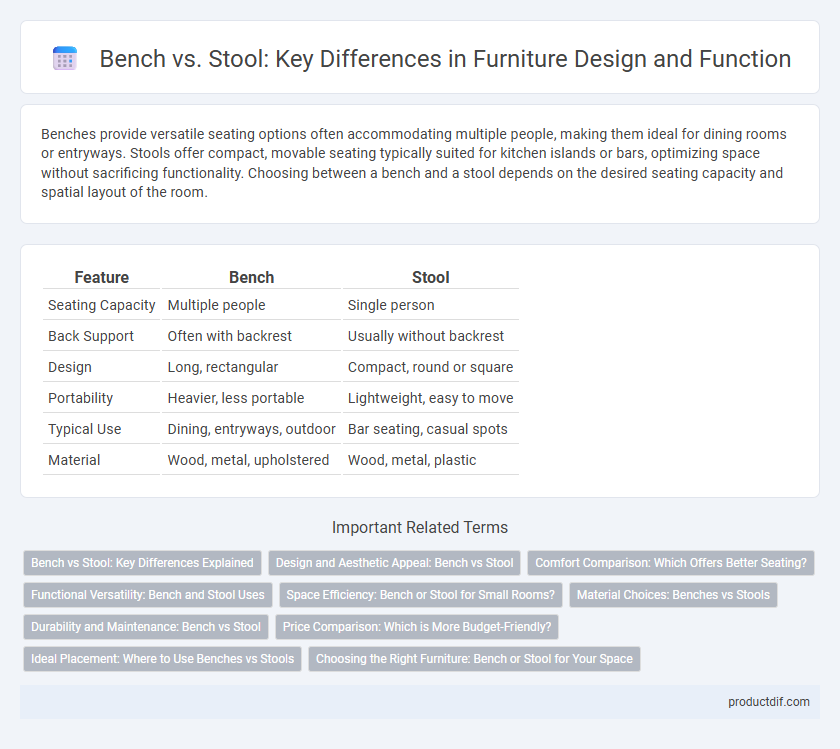Benches provide versatile seating options often accommodating multiple people, making them ideal for dining rooms or entryways. Stools offer compact, movable seating typically suited for kitchen islands or bars, optimizing space without sacrificing functionality. Choosing between a bench and a stool depends on the desired seating capacity and spatial layout of the room.
Table of Comparison
| Feature | Bench | Stool |
|---|---|---|
| Seating Capacity | Multiple people | Single person |
| Back Support | Often with backrest | Usually without backrest |
| Design | Long, rectangular | Compact, round or square |
| Portability | Heavier, less portable | Lightweight, easy to move |
| Typical Use | Dining, entryways, outdoor | Bar seating, casual spots |
| Material | Wood, metal, upholstered | Wood, metal, plastic |
Bench vs Stool: Key Differences Explained
Benches typically offer seating for multiple people with a longer, often back-supported design, while stools are usually single-seaters without backrests, making them more compact and versatile. Benches are commonly used in dining rooms, patios, and entryways, providing comfort and stability, whereas stools are favored for bar seating, kitchen islands, and small spaces due to their portability and ease of storage. Material choices for benches and stools vary widely, including wood, metal, and upholstered options, affecting durability and style.
Design and Aesthetic Appeal: Bench vs Stool
Benches showcase a versatile design accommodating multiple users, often featuring sleek lines and varied materials that enhance communal spaces with a balanced mix of comfort and style. Stools emphasize minimalism and portability, offering a compact, sculptural aesthetic ideal for modern, space-conscious interiors where visual lightness is paramount. Both bench and stool designs cater to different spatial dynamics, with benches serving as statement pieces and stools blending function with understated elegance.
Comfort Comparison: Which Offers Better Seating?
Benches provide superior comfort for extended seating due to their wider surface area and typically cushioned design, allowing for better weight distribution and posture support. Stools, often featuring minimal padding and smaller seating space, may cause discomfort during prolonged use but offer greater portability and space efficiency. Choosing between a bench and a stool depends on the intended duration and style of seating, with benches favored for comfort and stools for versatility.
Functional Versatility: Bench and Stool Uses
Benches offer functional versatility by accommodating multiple users simultaneously, making them ideal for dining tables, entryways, or outdoor seating areas. Stools provide compact, movable seating suitable for bars, kitchen islands, or workspaces requiring frequent repositioning. Both furniture types enhance space efficiency yet serve distinct practical needs based on user capacity and mobility.
Space Efficiency: Bench or Stool for Small Rooms?
Stools offer superior space efficiency in small rooms due to their compact size and ability to be tucked under tables or stacked when not in use. Benches provide flexible seating capacity but generally require more floor space and are less adaptable to tight corners. Choosing stools maximizes room flow and storage potential, making them ideal for constrained spaces.
Material Choices: Benches vs Stools
Benches are commonly crafted from durable materials like solid wood, metal, and upholstered fabrics to provide comfort and withstand heavy use in both indoor and outdoor settings. Stools often feature lighter materials such as molded plastic, metal, or wood, emphasizing portability and compactness for versatile seating options. The choice of material directly influences the functionality, aesthetic appeal, and maintenance requirements of benches and stools in various furniture designs.
Durability and Maintenance: Bench vs Stool
Benches generally offer greater durability due to their larger, sturdier construction, often made from solid hardwood or metal frames that withstand heavy use. Maintenance for benches involves regular checks for loose joints and surface refinishing to preserve longevity. Stools, while easier to move and typically lighter, may require more frequent tightening of screws and care to prevent wear on thinner legs and seats, making their upkeep more hands-on but straightforward.
Price Comparison: Which is More Budget-Friendly?
Stools generally cost less than benches due to their smaller size and simpler construction, making them a more budget-friendly seating option. Benches often require more materials and craftsmanship, resulting in higher prices, especially for those made from solid wood or featuring built-in storage. Consumers prioritizing affordability typically choose stools, while those seeking versatility may invest more in benches despite the higher cost.
Ideal Placement: Where to Use Benches vs Stools
Benches are ideal for dining rooms, entryways, and outdoor patios where multiple people can sit together comfortably, providing both seating and storage options. Stools work best in compact spaces like kitchen islands, bars, or workbenches, offering flexible, easy-to-move seating for individual use. Choosing benches enhances social interaction in larger areas, while stools optimize space and accessibility in smaller, functional zones.
Choosing the Right Furniture: Bench or Stool for Your Space
Benches offer versatile seating for multiple people, ideal for dining rooms or entryways where space maximization is key. Stools provide compact, flexible seating, perfect for kitchen islands or bar areas that require easy mobility and minimal footprint. Consider the intended use, available space, and style when choosing between a bench and a stool to enhance both function and aesthetic appeal in your home.
Bench vs Stool Infographic

 productdif.com
productdif.com